CDL Practice Tests: Flatbed Cargo Securement
Choose A Section:
Go!When securing paper rolls with eyes crosswise, which of the following can be used to prevent side-to-side shifting when there is more than 8 inches of space to the wall?
- Void fillers.
- Tiedowns.
- Any of these methods are acceptable.
- Friction mats.
Requirements for eyes crosswise: prevent rolls from shifting toward either wall
If there is more than a total of 203 mm (8 in) of space between the ends of a paper roll and other rolls or the walls of the vehicle, use one of these methods:
- Void fillers (such as honeycomb)
- Blocking
- Bracing
- Friction mats
- Tiedowns
When securing concrete bell pipe in multiple complete tiers, all of the following are true except:
- Bells of the upper tiers must all be on the opposite side of the vehicle from the bells of the tier below.
- Stack the tiers in pyramid fashion.
- Bells of the bottom tier must all be on the same side of the vehicle
- All of these apply.
More than one tier with complete tiers
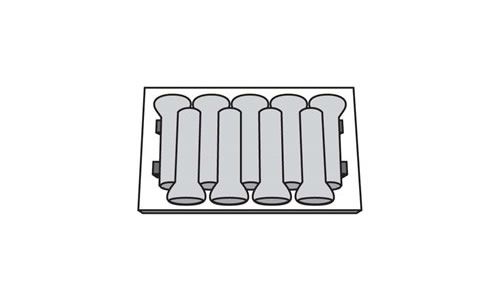
Bells of the bottom tier must all be on the same side of the vehicle
Bells of the upper tiers must be are on the opposite side of the vehicle from the bells of the tier below.
What types of freight need to be secured properly?
- Equipment used for vehicle operation.
- Intermodal containers.
- Hazardous materials.
- All freight should always be properly secured while driving.
-
Any cargo and dangerous goods/hazardous materials, including:
- All general freight.
- All equipment carried for vehicle operation.
- Intermodal containers and their contents.
- Some specific commodities have additional or different securement requirements (see later sections of this Handbook).
- Additional requirements under separate regulations may also apply for transportation of certain types of dangerous goods or hazardous materials.
Cargo
All of the following are requirements for dividing vehicles over 33ft except:
- Each tiedown must secure the highest log on each side of the center stake.
- Each tiedown must be fastened below the logs on each side of the center stake.
- Vehicle must be equipped with center stakes or comparable devices.
- Vehicle must be divided by center stakes into sections of staggered length.
Requirements for dividing vehicles over 10m (33 ft)
Vehicles over 10 m (33 ft) must be equipped with center stakes, or comparable devices, to divide it into sections of equal length.
Each tiedown must:
- Secure the highest log on each side of the center stake.
- Be fastened below these logs.
In case of low friction between the cargo and deck, which of these is not a solution?
- Put something heavy on top of the cargo.
- Use some kind of blocking.
- Attach tiedowns to the cargo.
- Set the cargo on friction mats.
What should you use in low-friction situations?
When there is low friction between the cargo and the deck (for example, with snow, ice, sand, gravel, and oil):
- Use tiedowns attached to the cargo.
- Use a means to improve the friction such as friction mats or tiedown that pass over the cargo.
- Use blocking and tiedowns.
When securing concrete pipe with a diameter of more than 45 inches loaded crosswise, how many tiedowns are required through each pipe at minimum?
- It depends on the weight of the pipe.
- 1
- 2
- 3
Requirements for securing the pipe
Secure each pipe with tiedowns through the pipe.
Run at least one tiedown through each pipe in the front half of the load. This includes the middle one if there are an odd number. The tiedown must run rearward at an angle not more than 45░ with the horizontal when viewed from the side of the vehicle, whenever practicable.
Run at least one tiedown through each pipe in the rear half of the load. The tiedown must run forward at an angle not more than 45░ with the horizontal when viewed from the side of the vehicle, whenever practicable. This holds each pipe firmly in contact with adjacent pipe.
All of these are requirements for securing longwood lengthwise except:
- Each end of the log should extend at least 3 inches beyond the stakes.
- Must be cradled in two or more bunks or contained by stakes.
- Each outside log should bear against at least two stakes, one near each end of the log.
- Secure each log with at least two tiedowns if shorter logs are carried on top of the stack.
Requirements for securing longwood loaded lengthwise
- Longwood must be cradled in two or more bunks or contained by stakes.
- Each outside log should bear against at least two stakes, one near each end of the log.
- Each end of the log should extend at least 0.15 m (6 in) beyond the stakes.
- If shorter logs are carried on top of the stack, secure each log with at least two tiedowns.
The term 'edge protector' refers to:
- A rail along the side of a vehicle that protects the side of the vehicle from impacts.
- A structure, device, or another substantial article placed against an article to prevent it from tipping that may also prevent it from shifting.
- A device placed on the exposed edge of an article to distribute tiedown forces over a larger area of cargo than the tiedown itself, to protect the tie-down and/or cargo from damage, and to allow the tiedown to slide freely when being tensioned.
- A vertical barrier placed directly behind the cab of a tractor to protect the cab in the event cargo should shift forward.
Edge protector:
A device placed on the exposed edge of an article to distribute tiedown forces over a larger area of cargo than the tiedown itself, to protect the tie-down and/or cargo from damage, and to allow the tiedown to slide freely when being tensioned.
High friction securement devices include:
- Friction mat
- These can all be used for securement.
- Cleated mat
- Piece of wood with friction surface
High Friction Devices
- Friction mat
- Piece of wood with friction surface
- Cleated mat
- Other specialized equipment
When loading and securing a boulder, it should be:
- Placed on symmetrical hardwood blocking that extends 3/4 of the length of the boulder.
- Placed on the vehicle with its largest or flattest side down.
- Supported on at least 2 pieces of 4in x 4in hardwood blocking, extending the full width of the boulder.
- All of these are requirements.
Requirements
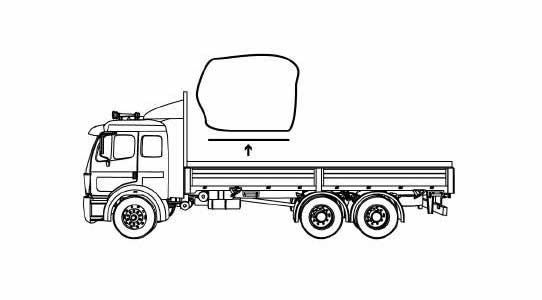
Place each boulder on the vehicle with its flattest and/or largest side down.
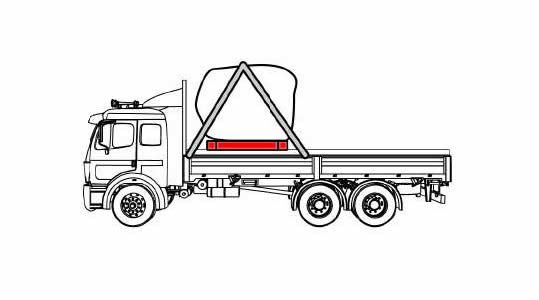
Support each boulder on at least two pieces of hardwood blocking (at least 10 cm x 10 cm (4 x 4 in) that extend the full width of the boulder.
Place hardwood blocking pieces as symmetrically as possible under the boulder so they support at least 3/4 of the length of the boulder.
About The Flatbed Cargo Securement CDL Manual
Studying the flatbed cargo securement CDL manual is not a requirement for getting your CDL permit or license. It is required knowledge for flatbed drivers.
Some questions you should be able to answer for flatbed cargo securement:
- What is the minimum Working Load Limit of a tiedown used to secure logs?
- What is the minimum weight of a shipment of paper rolls that would require specific securement requirements?
- When securing concrete pipe over 45 inches loaded crosswise, which direction must the tiedowns on the front half of the load run?
- What is a cab shield?
- When securing concrete pipe over 45 inches loaded crosswise, which direction must the tiedowns on the rear half of the load run?
- What is a dunnage bag?
- Who is responsible for inspecting securing devices and cargo within the first 50 miles?
- How many tiedowns are required on a stack of shortwood loaded crosswise?
- What is the minimum working load limit of each tiedown used to secure crushed or flattened vehicles?
- Define 'bolster'
- What is a hook-lift container?
- When a tiedown is attached directly to the cargo, what is the ideal angle where it attached to the vehicle?
What is a securing device?
Any device specifically manufactured to attach or secure cargo to a vehicle or trailer:
- Synthetic Webbing
- Chain
- Wire rope
- Manila rope
- Synthetic rope
- Steel strapping
- Clamps and latches
- Blocking
- Front-end structure
- Grab hooks
- Binders
- Shackles
- Winches
- Stake pockets
- D-rings
- Webbing ratchet
- Bracing
- Friction mat
What is a tiedown?
A combination of securing devices that forms an assembly that:
- Attaches cargo to, or restrains cargo on a vehicle.
- Is attached to anchor point(s).
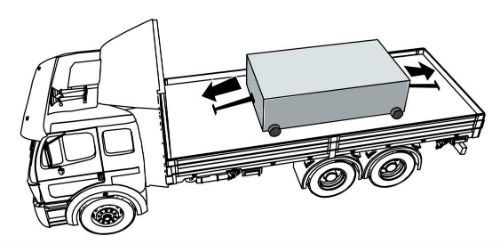
Some tiedowns are attached to the cargo and provide direct resistance to restrain the cargo from movement.
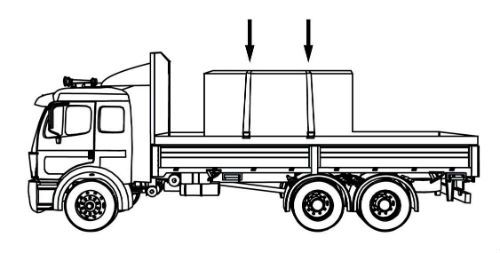
Some tie-downs pass over or through the cargo. They create a downward force that increases the effect of friction between the cargo and the deck. This friction restrains the cargo.
 Related Cargo Securement Terms That Every Driver Should Know:
Related Cargo Securement Terms That Every Driver Should Know:
-
Tiedown:
A combination of securing devices which form an assembly that attaches cargo to, or restrains cargo on, a vehicle or trailer, and is attached to anchor point(s).
-
Contained:
Cargo is contained if it fills a sided vehicle, and every article is in contact with or sufficiently close to a wall or other articles so that it cannot shift or tip if those other articles are also unable to shift or tip.
-
Blocking:
A structure, device, or another substantial article placed against or around an article to prevent horizontal movement of the article.
How should tiedowns be attached?
Tiedowns can be used in two ways:
-
Attached to the cargo:
- Tiedowns attached to the vehicle and attached to the cargo.
- Tiedowns attached to the vehicle, pass through or aroundan article of cargo, and then are attached to the vehicle again.
-
Pass over the cargo:
- Tiedowns attached to the vehicle, passed over the cargo, and then attached to the vehicle again.
Tiedown placement:

Place the tiedown as close as possible to the spacer.
Position the tiedowns as symetrically as possible over the length of the article.

Position the tiedowns to preserve the integrity of the article.







 TT On Facebook
TT On Facebook